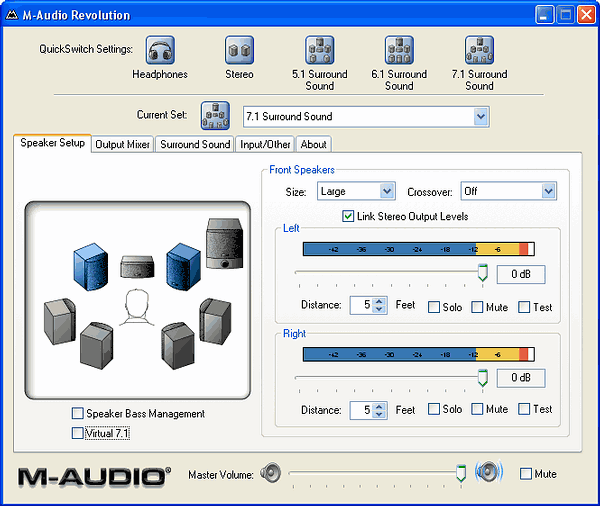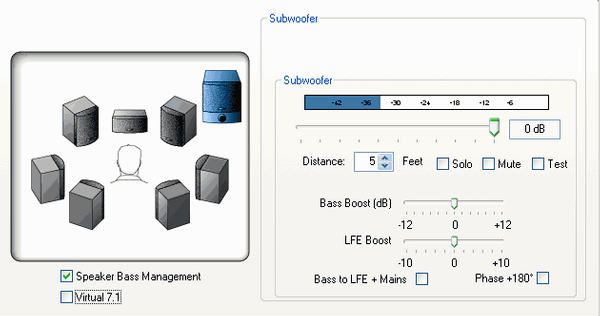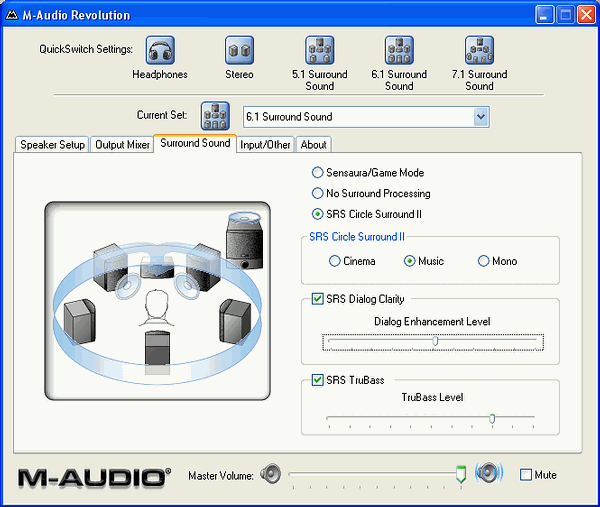 |
||
|
||
| ||
This spring M-Audio launched a new interesting audio solution - Revolution 7.1 sound card. M-Audio products are known as inexpensive quality semiprofessional solutions. The revolution means that this card is not professional but positioned mostly as a card for home theaters, playing music and games. It's for those who cares about sound.  The box contents
The thin brochure with the user guide written in English has all necessary information on installation and utilization of the sound card. One of the CDs contains demo versions of Ableton Live 2.0.1 and Propellerheads Reason 2.0 sequencers with a suite of loops, as well as the ArKaos VJlite 2.2.2 and WinDVD4. Appearance & Connectors
 Hardware capabilities
Software capabilities
Control panelThe control panel consists of a single window with 5 tabs. The upper part of the window shows configurations of the speakers. Beside 5 configurations in the Current Set there are also 2.1, 4.0, and 4.1 schemes available. You can save a certain configuration under its own name and then load it without making new settings. It's funny that the same Set Selection option also offers various presets called real acoustic models. They are 50 models in all from such companies as Altec Lansing, Creative, Harman Kardon, Logitech, Klipsch etc. The models have different specific parameters. Below you can find the Master Volume and Mute buttons.  The first Speaker Setup tab shows individual parameters of a channel selected. The left side highlights satellites adjusted. You can adjust a volume level for each channel, speakers' sizes, the LF filter cutoff frequency and latency (from 0 to 30 feet), and tick off Solo and Mute. The Test will send a sinusoidal signal into the channel selected.  The subwoofer settings also include LFE signal level adjustment and phase inversion enabling. The Speaker Bass Management supports Bass Boost LFE signal reproduction by satellites.  The Mixer shows indicators and volume level controls of outputs used in the speaker set configuration. You can adjust volume levels of channels, enable mute and solo functions. Also note that the channels unused are not available. For example, in case of the 5.1 configuration there is nothing in the place of back surround channels controls.  The Surround Sound tab has the option of enabling Sensaura algorithms. It's the advantage that rebooting in not needed after switching to the Sensaura/Game Mode: the panel reappears in a second the new mode enabled. It's also pleasant that with the Sensaura supported sound applications like Winamp working in the MME do not reproduce sound. The SRS Circle Surround option offers three algorithms of distribution of the stereo/mono signal into six or more speakers and two additional controls of the central satellite's level and the overall LF level.  The Input/Other tab incorporates the indicator and control of the input signal level. A clip indicator is also provided. On the right you can see sampling rates and ASIO buffer sizes available.  The last tab, About, indicates the drivers version. At the time of testing we used v5.10.00.0036. Tests in RMAA 5.1The card was compared to the reference one Lynx Two (117 dB SNR). A short low-noise microphone cable, Proel, with gold-plated connectors was used to connect the cards. The input sensitivity of the Lynx Two is standard: -10 dB V. The output signal amplitude is low, that is why the recorded signal was normalized up to the required level. Front outputMode of operation: 16 bit 44 kHz
General performance: Very good The detailed results for the front output for 16 bits 44 kHz are here.  THD level at 44 kHz is very low  The diagram of IMD (SMPTE) at 44 kHz demonstrates no artifacts from oversampling
General performance: Excellent The detailed results for the front output for 16 bits 48 kHz are here. Mode of operation: 24 bits 96 kHz
General performance: Excellent The detailed results for the front output for 24 bits 96 kHz are here. Line-in Mode of operation: 16 bits 44 kHz
General performance: Good
The detailed results for the front output for 16 bits 44 kHz are here. Mode of operation: 16 bits 48 kHz
General performance: Good The detailed results for the front output for 16 bits 48 kHz are here.
Digital-out
 IMD (SMPTE) spectrograms of the digital-out: the same jitter, not that bad
The detailed results for the front output for 16 bits 44 kHz are here. Tests in RightMark 3DSoundDirectSound diagnosticsDevice: M-Audio Revolution (revo.sys) Features:
Rates:
Free buffers stats:
Max buffers stats:
CPU load Windows XP SP1, DirectX8.1, Athlon 2100+, KT333, DDR333.
CPU load (%) for different modes of operation and a different number of DirectSound buffer. The average value and dispersion go after the slash (mean of distribution and standard deviation) for the 2-minute test and with accidental releases of the system discounted (swap etc.). Cubase SXThe M-audio Revolution 7.1, like other Envy24HT based cards, perfectly work in Cubase SX without any problems.  In the ASIO Buffer Size menu you can select a buffer size to optimize latency depending on the number of tracks, VST instruments, effects and sampling rates. Subjective testsMusicThe Event 20/20bas active monitors were used in the comparison tests. The Creative Audigy2 as a direct competitor in this price range was used as a reference card. Actually, we expected that the Audigy2 would sound better because its Audigy2 DACs have better specs. But the Revolution 7.1 showed a little advantage! Its sound was a bit more detailed and richer. However, you will hardly notice any difference on the acoustic systems up to $500. Secondly, with the SSRC plugin used in the Audigy2 the difference is vanishingly small, and it disappears at all if you listen the other card in 30 seconds. Tests in moviesThe next two tests were carried out on the Logitech Z-680. But this is only a 5.1 acoustic system, and given the analog connection, the front satellites reproduced the signal of the back surround speakers, and the active stereo speakers Microlab SOLO-1 was used in front. Before estimating the sound let me remind you something from the Creative Inspire 6.1 6700 Review. As to audio tracks in movies in cinemas and on DVD, 5.1 means that soundtracks are recorded in the format that consists of five main channels: left, center, right, left surround and right surround, plus a low-frequency effects bass channel (LFE). The suffix of ".1" indicates that the additional bass channel contains low frequencies from the main channels. Some soundtracks use the 5.1 format called Dolby Digital Surround EX which is currently entering the sphere of home theaters with DVD media. This format has the third surround channel encoded into the left and right surround channels of the 5.1 track with the matrix algorithm, and it can be decoded or left as is depending on whether the equipment used is compatible with this standard. Since additional information is stored in the left and right surround channels, the sound track in the Dolby Digital Surround EX format still represents the 5.1 format.  Obviously, a 5.1 track can be successfully played by the 5.1 acoustic system. It also can be played by 6.1 or 7.1 speaker sets. Two surround channels in a 5.1 track are distributed between 3 or 4 surround speakers. It can be done with a Dolby Digital EX decoder, THX Surround EX or other suitable equipment. Thus, a format describing a sound track (5.1, 6.1, 7.1) does not mean that it can be played only by a respective speaker set. It's also possible to play stereo content on a multi-channel acoustic set using a matrix decoder such as Dolby Pro Logic II. A source format and a speaker set operate independently, and a decoder is to manage them. There is actually one thing you should understand from the above abstract - the DolbyDigital Surround EX has 5+1 discrete channels, and data for additional channels are decoded with a matrix algorithm into left and right surround channels. But these two additional channels do not contribute much into the overall picture. In DVD movies recorded in the Dolby Digital/Dolby Digital Surround EX format the rear channels can be heard only in the scenes rich in effects. One more mono channel decoded in two rear channels in not noticeable at all... This technology is well suited for cinema halls. But a user sitting in front of a PC monitor doesn't need a 7.1 system at all. It looks like one more marketing step, the attempt to attract users' attention to new capabilities of sound cards. In movies the Audigy 2 and M-Audio Revolution 7.1 play equally. But there is one interesting thing. The Audigy 2 has its own decoder, and the Audigy2 could have an advantage if its decoder performed better than the one used in the WinDVD. However, the decoder in the WinDVD Platinum 4.51 plays much better. Tests in gamesThe listening tests were carried out in Unreal Tournament 2003 and Soldier of Fortune II. To estimate the relative sound quality we used the Audigy 2 card again. We listened to the same game episodes switching the cards as fast as possible. The sound coming from the M-Audio Revolution 7.1 i inferior to the Audigy 2: it's less clear and detailed. We actually expected that from the Sensaura. Sensaura never won against Creative starting yet from the Live! and EAX2.0. The Revolution's strong point is not games at all. And realization of the Sensaura algorithms in this card should be regarded as a bonus. Nevertheless, you can play games with this card, - the sound is not that bad (for a card with the Sensaura). Sound in headphonesWith the Senheiser HD600 headphones the card produces a clear signal without distortions even at the maximum volume level. In games with the Sensaura support we didn't have to turn up the volume over 30% in spite of the drop in the volume level. ConclusionThe card plays pretty well, and it's easy to handle it. Although the realization of the 24bit/96kHz mode is not of high quality and it is the most difficult mode for many cards, the 16bit/44kHz mode sounds excellently. The comparison with the Audigy2 was one of the most important tests. The Creative's solution is a bit inferior in music, but when coupled with the SSRC, it almost catches up with the Revolution. But remember, that you can notice the difference only on high-quality speakers. In games Creative's cards maintain its leading position because competitors have nothing to beat them with (the Sensaura technology is obsolete and doesn't suit anymore for cards with so good sound). Highs
Lows
Write a comment below. No registration needed!
|
Platform · Video · Multimedia · Mobile · Other || About us & Privacy policy · Twitter · Facebook Copyright © Byrds Research & Publishing, Ltd., 1997–2011. All rights reserved. |